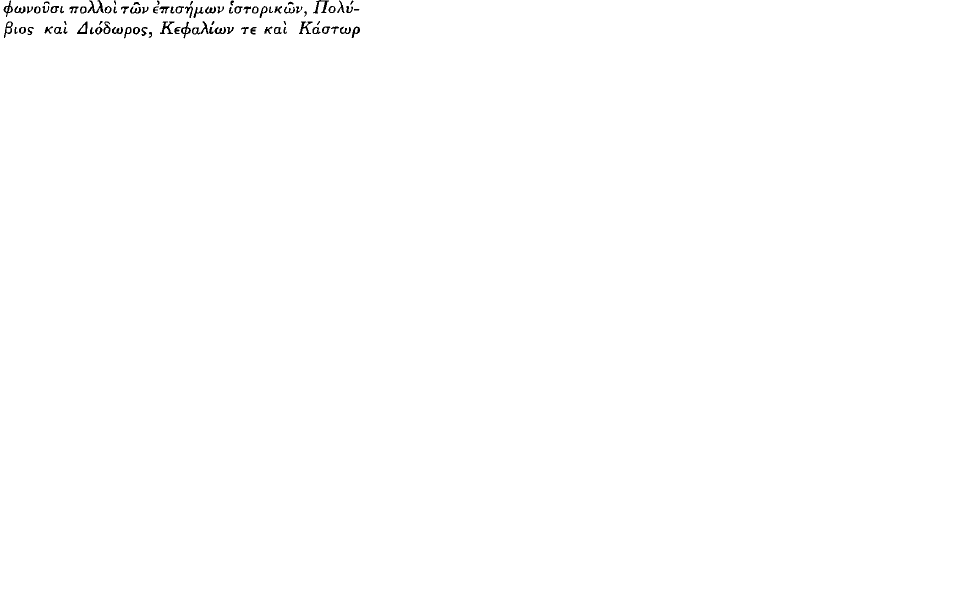No CrossRef data available.
Published online by Cambridge University Press: 11 February 2009
Chapters 3 and 4 of Book 80 of Dio Cassius, dealing with the founding of the new Sassanid dynasty in Persia, have to be reconstructed from Xiphilinus on the one hand and the Excerpta Valesiana on the other. Zonaras 12. 15 in turn excerpts Xiphilinus; but Zonaras 12. 15, p. 572. 7–10 B. is not to be found in either of the excerptors of Dio. The words are as follows:
page 82 note 1 Cf. Dio Cassius ed. Boissevain, , iii (Berlin, 1901), p. 477.Google Scholar
page 82 note 2 ‘Römische Kaisergeschichte in byzantinischer Fassung i’, B.Z. i (1892), 27 f.Google Scholar
page 82 note 3 Op. cit., p. 29.Google Scholar
page 82 note 4 Op. cit., p. 30.Google Scholar
page 82 note 5 That he utilized only Panodorus and Annianus, supplementing them from ‘die heilige Schrift’ (op. cit., p. 30).Google Scholar
page 82 note 6 Agathias' name is not mentioned by Patzig, E., ‘Ober einige Quellen des Zonaras’, B.Z. v (1896), 24–53,Google Scholar vi (1897), 322–56, or by Boissevain, , op. cit., who says of Zonaras 12. 15 pp. 572. 7–10 and pp. 572. 22–573. 2 ‘de eorum origine nihil definio’.Google Scholar
page 82 note 7 Syncellus, , pp. 676. 15–678. 11.Google Scholar
page 82 note 8 Agathias, 2. 25, pp. 119. 10–124. 7.Google Scholar
page 83 note 1 As for instance Agathias' work is headed in Vat. graec. 152 

page 83 note 2 Cf. Christensen, A., Les gestes des rois dans les traditions de l'ran antique (Paris, 1936), p. 81.Google Scholar
page 83 note 3 Cf. Th. Nöldeke, , Geschichte der Perser und Araber zur —eit der Sasaniden, aus der arabischen Chronik des Tabari (Leyden, 1879), p. 400, n. 1. Syncellus' list, extracted from the continuous narrative in Agathias 4. 24, pp. 258 f., reduces that of Agathias to round numbers.Google Scholar
page 83 note 4 2. 27, p. 124. 5.
page 83 note 5 On whom cf. Jacoby, , F.Gr.H. 273 F 81.Google Scholar
page 83 note 6 It did not matter for Syncellus that such passages might contain wrong or misleading citations—cf. p. 172. 17, where for a 1460-year Assyrian duration he says 

 although he knows that Diodorus' figure was 1300 (p. 313. 18) and Castor's 1280 (p. 318. 5). For the practice in general cf., e.g., Peter, H., Gesch. Lit. über die röm. Kaiserzeit, ii. 253 f.Google Scholar
although he knows that Diodorus' figure was 1300 (p. 313. 18) and Castor's 1280 (p. 318. 5). For the practice in general cf., e.g., Peter, H., Gesch. Lit. über die röm. Kaiserzeit, ii. 253 f.Google Scholar
page 83 note 7 The passage in Agathias is followed immediately by a long section on the hollowness of Chosroes I's pretensions to knowledge of Greek philosophy, a subject which evoked a surprising warmth in our author.
page 84 note 1 Op. cit., p. 28.Google Scholar